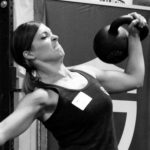Two things you should know about me right from the start:
- I love running. It’s something I’ve been doing for fifteen years (along with quite a bit of competitive cycling) and I owe much of who and where I am to the sport.
- I haven’t really considered myself much of a strength athlete until just two years ago.
Had I been to a gym before that? Absolutely. I remember being fresh out of high school, running and working out in my local gym. I loved it. I was young and had no idea what strong was or what I was doing, but I knew I was falling in love with an active lifestyle. Even when I was an extremely dedicated marathoner and Cat. 1-2 cyclist, I knew I felt stronger if I made a little time for the gym.
My Story of Cycling, Skipping the Weights, and Burnout
But when I started getting serious about cycling, my coaches warned me that I simply didn’t need upper body strength. It was dead weight. For three years I raced my bike at a very competitive level. I fell into their way of thinking and all but stopped any strength training I was doing. To be honest, I always felt like I was giving something up. My body may have been a bit more sport specific, but I knew I didn’t feel as healthy.
Two years ago, I totally burned out. I hurt every time I ran or rode the bike, and I kept getting injured. I thought I was getting old. I started talking to a good friend of mine, Dave Buckles, a former Marine who’s done Ironman triathlons, raced his bike across the United States, and has a degree in Exercise Science Kinesiology. At the time, he was also running a CrossFit gym.
For a while, our relationship went a little like this: I kept telling him how bad my back hurt when I ran or how tight my calves were. He kept telling me I should come into his gym and work on my core strength and flexibility. I wouldn’t listen. I just didn’t get it—and I kept re-injuring myself. I had become too complacent and too stuck in what I like to call “tunnel vision training”—when you’ve been around a sport so long that you assume that if a practice, exercise, or training discipline isn’t part of your sport’s “culture” then you automatically mistrust, discount, and belittle it. After all, you’ve been doing this for fifteen years, you have friends that have been doing it for longer—you know what’s right!. Right?
But I knew I needed a change. I took Dave’s advice, went into his gym, and started a CrossFit and strength program. To keep a long story short, I’ll just say it’s absolutely revolutionized the way I train, eat, rest, and do almost everything else when it comes to my endurance groundwork. I now am happy to say that I can attend CrossFit classes three days a week and run five days a week, while still performing under the three-hour mark in the marathon.
What Does This Have to Do With You?
Why do you care if some runner decided to pick up a barbell? I’m telling you all this because I know who I’m writing to. I know we hang out on opposite ends of the strength-endurance spectrum, but I know everyone who reads this, because of the basic, no-bull principles StrongFirst teaches is a quite a bit different than your typical gym rat.
You guys are smarter and more intuitive with your bodies. I know you appreciate intelligent training. I know you’ll see the inherent value in adding some running into your strength training. Whether you want to run because, like me, it’s time to change it up a bit, step out of the box, and give yourself a challenge that may teach you a few things, or you’ve been toying with the idea of running a local 5K, 10K, or maybe even the popular Spartan Races, the fact is, you can incorporate running into your training without sacrificing strength gains and feeling too tired to lift. Trust me. If I can do it, you can.
How Your Body Adapts to Running and Strength Training
Before I get to the running program, let’s talk about how your body adapts. I was told not to lift because my body would build muscle mass that wasn’t serving a sport-specific purpose and then I’d have to carry it up hills. For strength guys, it’s the opposite: aerobic exercise reduces the size of certain muscle fibers so they can act more efficiently—so blood flow becomes easier—exactly what you want in an endurance event. But this reduction is only in type 1 fibers, which (for the most part) are not what you use when doing any type of heavy lifting. Studies have shown that even with a small amount of strength training, this type of change can be prevented in the fibers. Adding running to your routine in the amount I’m discussing will not jeopardize strength gains.
But you need to eat! Running takes up energy—a lot of energy. If, after starting a running program, you feel like you’re losing strength and not able to go quite as hard as you want to in a workout, the first thing I would look at is calorie intake. You’ll go through the same amount of glycogen in fifteen minutes of running as you will in two hours of strength training. There’s no way around this. You need to fuel the fire to keep it burning.
Speaking of glycogen, we need to talk about how your body uses energy to produce movement during activity. Although all three of the following energy substrate systems are being used in the body at all times, it’s the degree in which they are used during certain types of activities that we are concerned with.
- For intense, quick bursts of activity lasting five to fifteen seconds, the body looks to ATP and creatine phosphate—this should be the energy source most familiar to strength athletes.
- Next, glucose is utilized for any work lasting from twenty seconds to about two minutes.
- After that, the body starts looking towards fat stores for efforts lasting longer than a couple minutes.
Again, depending on what you are doing, the body will utilize one substrate over another. The key is the realization that because glucose and fat stores aren’t the energy employed during a heavy lift day, you will still be able to put a long run in the next workout. During lifting, you will need longer breaks to give your body time to re-synthesize its short effort energy stores (glycogen), whereas an endurance athlete who is being fueled more by carbohydrates wouldn’t necessarily need as much time.
The bottom line is that running will not affect the energy needed for a hard lifting day. The limiting factor will be fatigue in the muscles due to the new trauma running introduces over an extended amount of time—a point to keep in mind as you decide which days to rest and which days to run and train.
A Running Program for Strength Athletes
And with that, I’ve created a sample program for strength athletes who are looking to incorporate running into an already busy strength schedule.
I’m assuming a few things here:
- You are lifting about five times a week. If you’re lifting less, you’re more than welcome to add a run that is more speed intense or has you running up hills (both will build your quickness).
- You can comfortably run at least a mile and a half already.
- I’ve designed this program to get you ready for a 10km (6.2 mile) race. That race would fall on the third day of running for the last week (week 10). You’ll notice that you taper your runs during that week to keep you fresh for the race.
I’m not going to make it any more complicated than that, here it is:
| Week | Run 1 | Run 2 | Run 3: Long Run |
| 1 | 2 mi | 1.5 mi | 3 mi |
| 2 | 2 mi | 1.5 mi | 3.5 mi |
| 3 | 2.5 mi | 2 mi | 3 mi |
| 4 | 2.5 mi | 2 mi | 3.5 mi |
| 5 | 2.5 mi | 2 mi | 4 mi |
| 6 | 3 mi | 2 mi | 4 mi |
| 7 | 3 mi | 2 mi | 4.5 mi |
| 8 | 3 mi | 2 mi | 5 mi |
| 9 | 3 mi | 2 mi | 5.5 mi |
| 10 | 2 mi | 1.5 mi | 10k Race! |
Choose which of your lifting days best compliment when you would want to run. It’s okay to do a intense strength workout and then run after (as long as you are eating properly), but I wouldn’t go out to do your long run in that same day. Make sure your rest days are planned wisely. A rest day should be a day when you don’t strength train or run.
Maybe you’re already comfortable at the 10km distance and want to go a bit farther. Here’s what a good program for running ten miles would look like. This is assuming you already can comfortably complete a 10K. You’ll note the third week in this cycle has you running less mileage. The reduction is repeated in week 7, as well. This is to facilitate recovery, give the body time to adapt to the new stress, and avoid injury (in other words, this isn’t a typo).
| Week | Run 1 | Run 2 | Run 3: Long Run |
| 1 | 6 mi | 4 mi | 7 mi |
| 2 | 6 mi | 4 mi | 7.5 mi |
| 3 | 4 mi | 4 mi | 6 mi |
| 4 | 6 mi | 5 mi | 8 mi |
| 5 | 6.5 mi | 5 mi | 8.5 mi |
| 6 | 6.5 mi | 5 mi | 9 mi |
| 7 | 5 mi | 4 mi | 6 mi |
| 8 | 7 mi | 5 mi | 9.5 mi |
| 9 | 7 mi | 5 mi | 9.5 mi |
| 10 | 7 mi | 5 mi | 10 mi |
Remember, a good run means you warm-up for five to ten minutes by running slowly and easing into your pace. When you’re finished, incorporate ten minutes of active stretching and foam rolling. On top of that, make sure you are hydrating properly when finished. Recovery and re-hydration becomes more and more essential the farther you run—I never skip either of these and neither should you.
Add Stamina to Your StrongFirst Base
So there it is, two easy-to-follow programs that will improve your aerobic ability drastically without compromising strength days. I’m a firm believer that the strength I’ve gained has made my running much more efficient and less taxing on my body as a whole.
For someone who is StrongFirst, the addition of a solid aerobic base (from following this basic 10km program) will not only give you a new challenge to work on, but you’ll undoubtedly notice an increase in stamina as your body adapts.








What level of intensity should we perform the runs at? Are these lsd runs or should we push it and try to beat times each week?
Also what if your not racing and you just want to be better at mid distance running. How should we progress with this over the long haul? Thanks.
Great article.
Hey Joel,
As a multisport athlete, I am curious on how you fit everything in. I have done quite a few 10k’s, sprint tri’s and strength train with KB’s 2-3X a week. I have done some decent races in the past, but now my brothers have thrown down the gauntlet on an upcoming 10K and I am trying to figure out how to manage my training time. Here is what I do today and an wondering what you would suggest on how to alter it to train for a really strong time (along with eating really clean between now and then).
Now
Monday-circuit training
Tuesday-masters swim (1 hour of solid swimming)
Wednesday-spin
Thursday-heavy day
Friday-masters swim (1 hour of solid swimming)
Saturday-long run+kb circuit
Sunday-short ride (cycling is my least favorite of the tri sports, so unless i am training for something, i keep this pretty short-20ish miles)
I have arthritis in my joints, so I don’t want to run more than 2-3x a week. I have found that as long as I run 1x a week i can go out and have some good times in races..but certainly not pr’s.
Would you recommend cutting out one of the above and sub a run in or just doing the runs in the evening?
Great article!,,
I have to run because I’m still in the Military. I found that VO2 max and snatches in general have helped my run speed and endurance BIG TIME. It helped even more than intervals and repeats.
Thanks for the great article, it will help me convince myself that my running isn’t hurting my press.
What exercises help you with your running? which ones help prevent injury? Thanks!!!
John,
Great questions. I’m a firm believer that the only way to train to run is to actually run. Nice and simple. But that doesn’t really answer your question. I like calf raises, pistols and squats if we’re talking about your legs, but a strong core is phenomenally important for running. Ever see runners, at the end of a long race like a marathon, hunched over in agony or even almost bent in half? Yep, core strength. Strong core means you are more efficient and much less likely to get injured.
As far as exercises for preventing injury, I’ll just go over some injury prevention basics: GET GOOD SHOES that are designed for your personal gait. If you don’t know what I’m talking about, go to a local running specialty shop and ask them. You’ll be so happy you did. I’m a big believer in foam rolling and active stretching. I can’t emphasize these two enough. However, the biggest problem I see time and time again is people who are overzealous and don’t know how to rest. You need days off! It’s an important part of any exercise program. Just like adequate sleep is an important part of your day. If you stay consistent and allow your body time to rest, recover, and adapt, generally you shouldn’t see too many injuries. And let’s not forget that the flexibility and strength you learn with StrongFirst will go a very very long way in making sure you don’t get injured.
Thanks,from a Spartan racer. I appreciate your time and advice. Much obliged!